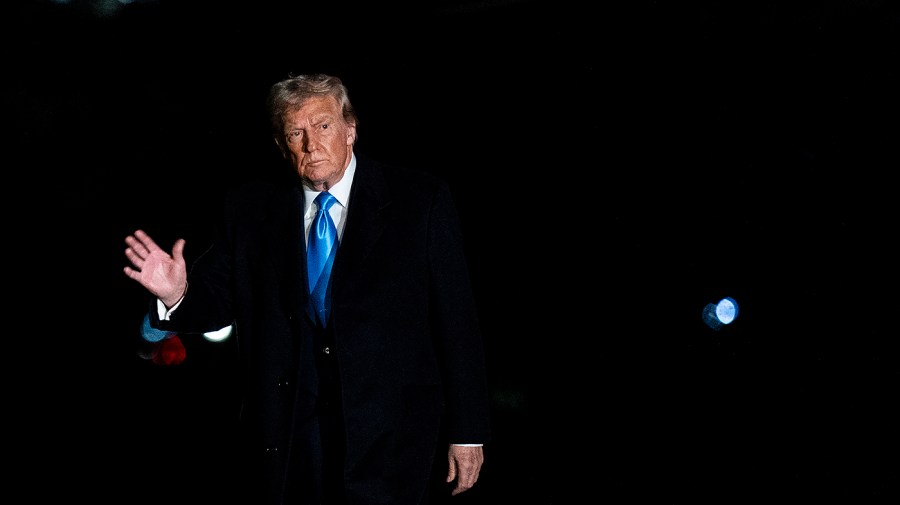
President Trump signed orders this weekend imposing 25 percent tariffs on Canada and Mexico and a 10-percent tariff on China, but U.S. trade posture toward its three biggest trading partners seems once again to be in flux.
Trump spoke Monday with Mexican president Claudia Sheinbaum. He said on social media Monday morning that they “agreed to immediately pause the anticipated tariffs for a one month period” as broader negotiations over border security and trade begin between the two nations.
Trump said he looks “forward to participating in those negotiations, with President Sheinbaum.”
Trump spoke Monday morning with Canadian Prime Minister Justin Trudeau and is expected to speak with him again Monday afternoon, prior to a Tuesday effective date for the 25-percent tariff on Canada.
A Saturday White House statement said that “such rate of duty shall apply … on or after 12:01 a.m. eastern time on February 4, 2025.”
A White House spokesperson told The Hill Monday morning that the tariffs go into effect at noon on Tuesday — Mexico tariffs aside.
The new tariff delays come after Trump pledged to enact import taxes on his first day in office, but later delayed the announcement until Saturday. At least some of the tariffs announced over the weekend will be iced once again.
It took Trump two years during his firm term to renegotiate the NAFTA trade deal that became the U.S.-Mexico-Canada Agreement (USMCA), a deal that included labor and environmental standards left out of NAFTA and that made it easier to punish companies for breaking them.
The business world is bristling as it attempts to figure out whether Trump’s promises on tariffs will come pass.
Here are five things to know about Trump’s tariff fight with Canada and Mexico.
Trump’s argument for going after close trading partners
Trump has been threatening tariffs on Canada and Mexico to encourage them to stop the flow of migrants and drugs between borders.
The U.S. has been dealing with an opioid crisis for years and South and Central American migrants regularly cross into the U.S. from Mexico, driven by a lack of regional economic opportunity, crime and governance concerns, and even the effect of climate change on agricultural conditions.
Tariffs as a solution to these complex international problems allow Trump to use the nationalist messaging that has long been a part of his America First branding.
“Gang members, smugglers, human traffickers, and illegal drugs and narcotics of all kinds are pouring across our borders and into our communities,” the White House said in its Saturday tariff announcement.
The tariff threat also allows Trump to tap into a politically potent vein of economic protectionism that resonates with his supporters.
Frustrations about globalized supply chains and the outsourcing of jobs to low-wage countries go back decades, especially to the 1990s when a spate of free trade deals were passed culminating in the admission of China to the World Trade Organization. In many parts of the country, NAFTA is still a dirty word.
Trump has also taken issue with the trade deficits run between the U.S. and each of its neighbors. While the president says it is unfair for Americans to buying more goods from Canada and Mexico than those countries buy from the U.S., most trade economists attribute the deficit to the comparative strengths of each economy, along with the sheer level of U.S. demand for foreign goods.
How Canada and Mexico are reacting
Canada and Mexico — two of the top three U.S. trade partners — are reacting to the threat of tariffs with a mixture of bluff-calling and saber-rattling.
Ontario Premier Doug Ford said Sunday that Canada is banning U.S. companies from provincial government contracts.
“U.S.-based businesses will now lose out on tens of billions of dollars in new revenues. They only have President Trump to blame,” he wrote on social media.
Ford said he’s targeting Trump advisor Elon Musk’s satellite company Starlink.
“We’ll be ripping up the province’s contract with Starlink. Ontario won’t do business with people hellbent on destroying our economy,” Ford wrote.
Sheinbaum reiterated Trump’s Monday message about the tariff pause, saying she was sending additional troops to the U.S. border to help stop fentanyl traffickers. She added Wednesday she thought the tariffs were a bluff and that they wouldn’t happen, shortly before striking a deal that would prevent them from being implemented for now.
Widespread backlash among different groups
Trump’s tariff promises under the International Emergency Economic Power Act (IEEPA) drew near-universal criticism from business trade groups over the weekend, while also getting blasted by trade advocates critical of free trade deals.
“The imposition of tariffs under IEEPA is unprecedented … and will only raise prices for American families and upend supply chains,” the U.S. Chamber of Commerce, one of the biggest business lobbies in the U.S., said in a Saturday statement.
Tariffs are taxes paid by individuals and companies that import goods from abroad, and they don’t directly raise prices. Specifically, they’re taxes at the wholesale level, not the retail level that consumers pay.
Companies can react to them in various ways, including raising prices and preserving margins, switching to a domestic supply chain, ceasing to sell a particular good, or taking a hit on their profit margins and keeping their prices steady.
Trade advocate Lori Wallach, director of Rethink Trade, who often fights against corporate positions on trade policies, said the tariffs “make no sense.”
“Using tariffs to try to achieve [the goals of stopping fentanyl trafficking and unauthorized migration] is like trying surgery using a saxophone – wrong tool!” she wrote in an analysis on social media.
“If the goal is US manufacturing revival, tariffs must be paired with policies for industrial capacity investment, demand for US-made goods & to stop price-gouging & ease unionization so corporations that made record profits pay for the adjustment, not workers and consumers,” she wrote.
The products and industries that will be hit hardest
Among the industries that will be hit hardest by tariffs on Mexico and Canada is the auto sector, since component auto parts often travel back and forth over borders in the course of production.
Linda Hasenfratz, chair of auto component maker Linamar, said on an Automotive News podcast last week that North American auto production would simply shut down as a result of the tariff.
“If 25-percent or 10-percent tariffs are imposed on auto parts, I’m going to say [it’s] not more than a week before production halts,” she said.
Trump has proposed a 10-percent tariff specifically on Canadian oil and gas, which could be felt throughout many different economic sectors. A 25-percent tariff on Canadian lumber would likely have an impact on the U.S. housing and construction industries.
“Tariffs on lumber and other building materials increase the cost of construction and discourage new development,” Carl Harris, chairman of the National Association of Home Builders (NAHB), said in a Saturday statement.
The plastics industry, which makes components used in many different user-end industries, would also be hit hard.
“A blanket tariff policy could have significant economic consequences, disrupting the movement of essential machines, products, and materials that keep American manufacturers running,” Plastics Industry Association president Matt Seaholm said in a Saturday statement.
Retaliatory tariffs are like to target the agricultural sector and were implemented by China during the first Trump trade war in 2018.
“Agriculture is generally the first target generally because there are other sources,” Bill Reinsch, chair of international business at the Center for Strategic and International Studies, told The Hill. “It strikes at one of the strongest areas of Trump’s support. In 2018, what he ended up having to do was, he basically bought off all the farmers.”
The significance of using IEEPA to impose tariffs
There are various legal statutes that can be invoked to issue tariffs, including Section 301 of the 1974 Trade Act, which Trump used in 2018.
The current proposed tariffs would be carried out under the International Emergency Economic Powers Act (IEEPA), which is a more serious law with a national security dimension that extends beyond the regulation of commerce and sends a stronger message.
IEEPA, similar to the Trading with the Enemy Act (TWEA) from which the law is derived, “sits at the center of the modern U.S. sanctions regime,” according to the Congressional Research Service.
Wallach said IEEPA presents Trump with the “speediest authority a president can access” to make good on a tariff threat.
“Maybe fentanyl/migration were named as ‘emergencies’ to gain use of the Int’l Emergency Economic Powers Act, the speediest authority a president can access for tariffs?” Wallach speculated.











